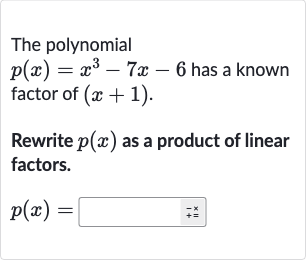AI tutor
Welcome to Bytelearn!
Let’s check out your problem:

The polynomial has a known factor of .Rewrite as a product of linear factors.
Full solution
Q. The polynomial has a known factor of .Rewrite as a product of linear factors.
- Factor Finding Method: Since we know that is a factor of , we can perform polynomial division or use synthetic division to divide by to find the other factors.
- Synthetic Division Setup: Let's use synthetic division to divide by . We set up the synthetic division with (the zero of the factor ) and the coefficients of : (for ), (for , since there is no term), (for ), and (constant term).
- Performing Synthetic Division: Performing synthetic division, we bring down the leading , multiply it by to get , add this to the next coefficient to get , multiply by to get , add this to to get , multiply by to get , and add this to to get . The result of the synthetic division is the coefficients of the quotient polynomial: (for ), (for ), and (for the constant term).
- Quotient Polynomial: The quotient polynomial is . We can factor this quadratic polynomial to find the other linear factors of .
- Factoring Quadratic Polynomial: Factoring , we look for two numbers that multiply to and add to . These numbers are and . Therefore, factors into .
- Final Solution: Now we can write as a product of its linear factors: .
More problems from Find the inverse of a linear function
QuestionGet tutor help
QuestionGet tutor help
QuestionGet tutor help
QuestionGet tutor help
QuestionGet tutor help
